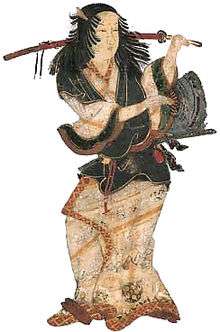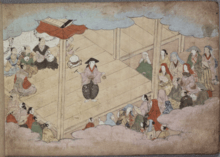Izumo no Okuni
Okuni (出雲阿国, Izumo no Okuni, born ca. 1572; died ca. 1613) was a Japanese shrine maiden who is believed to have invented the theatrical art form of kabuki. Thought to have begun performing her new art style of "kabuki" (lit., "the art of singing and dancing") theatre in the dry riverbed of the Kamo River in Kyoto, Okuni's performances gained immense popularity, and were known for their performances, who were often lower-class women Okuni had recruited to act in her all-female troupe.
Izumo no Okuni | |
|---|---|
 Okuni dressed as a samurai | |
| Born | c. 1572 Izumo Province |
| Died | c. 1613 |
| Nationality | Japanese |
| Occupation | Kabuki Actress |
| Known for | Invention of Kabuki Theater |
| Partner(s) | Nagoya Sansaburō |
Few concrete details are known about her life; born around 1572 near Izumo province, Okuni worked as a miko (shrine maiden) for several years at the Izumo-taisha (the Grand Shrine of Izumo) until gaining popularity for her dramatised dance performances, which onlookers gave the name of kabuki. Okuni continued to perform kabuki with her troupe until her retirement and disappearance sometime around 1610. She is believed to have died sometime around 1613.
History
Early years
Born c. 1572,[1] Okuni grew up in the vicinity of the Izumo shrine, where her father, Nakamura Sanemon, worked as a blacksmith, and where several other family members served. Eventually Okuni joined as a miko (shrine maiden),[2] where she was known for her skill in dancing and acting, as well as her beauty. As it was a custom of the time to send priests, miko and others to solicit contributions for the shrine, she was sent to Kyoto to perform sacred dances and songs.[2]
It was during her performances in Kyoto that she also became known for her performances of nembutsu odori (or nembutsu dance) in honor of the Amida Buddha. Though this dance traces its origins to Kūya, a tenth-century evangelist of Pure Land Buddhism, by Okuni's time it had become a largely secular folk dance, and her particular adaptation tended to be known for its sultriness and sexual innuendo.[3] Other popular themes for Okuni's acts included humorous skits about lover's trysts at various public establishments and meetings between men and prostitutes. Between these and other dances and acts, she garnered much attention and began to draw large crowds wherever she performed. Eventually she was summoned to return to the shrine, a call she ignored, though she continued to send money back.[1]

Founding of kabuki
Around 1603, Okuni began performing on the dry riverbed of the Shijōgawara (Fourth Street Dry Riverbed) of the Kamo River[4] and at Kitano Shrine.[5] Okuni also performed for the ladies of the imperial court.[1] Gathering up the female outcasts and misfits of the region, particularly those involved in prostitution,[3] Okuni gave them direction, teaching them acting, dancing and singing skills in order to form her troupe.
Several theories exist as to the etymology of the word "kabuki", one being that it is derived from those who, oddly dressed and swaggering on the street, had been dubbed 'kabukimono' (from "kabuku", "to lean in a certain direction", and "mono", "people"). Another possible origin is 'katamuki', which means "slanted" or "strongly-inclined."[3] In either case, others labeled Okuni's troupe's performances "kabuki" due to their eccentricity and social daring. The earliest performances of kabuki were dancing and song with no significant plot, often disdained as overly sexual and cacophonous, but equally lauded as colourful and beautiful.[6]
Okuni's troupe was exclusively female. Thus, she required her actresses to play both male and female roles. As her troupe gained fame, she was emulated by many others, particularly brothels, which offered such shows to amuse wealthy clients, as well as to gain prostitutes who had marketable acting and singing skills. This new style of exclusively female troupes became known by the alternative names of "shibai" and "onnakabuki",[7] (from "onna", the Japanese word for "woman" or "girl") and "Okuni kabuki".[5]
Later years
Eventually, with the aid of Nagoya Sansaburō, who supported Okuni financially as well as artistically,[8] kabuki evolved into a more dramatic style. On a more personal level, Sansaburō was also said to be Okuni's lover, though they never married.[9] After his death she continued without him, continuing to merge the drama with the music and dance. Eventually, her fame and that of her kabuki troupe spread throughout Japan.[1]

Okuni retired around 1610, and after that time she disappeared. In 1629, due to outcry for moral reform and concern about fights breaking out between men trying to win the attention of the actresses, shōgun Tokugawa Iemitsu forbade women from performing in kabuki.[6][1] They were quickly replaced by young men as actors/"actresses", though this was soon banned as well due to some of the same issues of prostitution and corruption of morals, restricting the performances to those by older men, which is a standing practice in the official theatres even today.[3]
There are several conflicting theories of Okuni's year of death; some say she died in 1610,[2] others in 1613,[10] or in 1640.[7]
Cultural impact
In addition to her founding of kabuki, Okuni contributed to Japanese theatre as a whole. She is said to have introduced the forerunner of the hanamichi (path of flowers), a runway leading from the rear of the theatre and crossing between the audience to the stage.[11] This has been incorporated in several Japanese theatre arts beyond that of kabuki. In addition, she has also influenced modern musical theatre.[11]
In November 2002 a statue was erected in her honor and to commemorate 400 years of kabuki.[12] The statue stands at the east end of the Shijō Ōhashi bridge crossing the Kamo River diagonally across from the Minami-za, the last remaining kabuki theater in Kyoto.[13]
References
Citations
- National Guitar Workshop 2008, p. 270.
- Scott 1955, p. 55.
- Varley 2015.
- "Okuni | Kabuki dancer". Encyclopedia Britannica. Retrieved 2019-05-05.
- "Okuni". Japan: An Illustrated Encyclopedia. Kodansha. 1993. ISBN 9780028972039.
- "KABUKI: HISTORY, THEMES, FAMOUS PLAYS AND COSTUMES". Facts and Details. Facts and Details. Retrieved 25 May 2020.
- "Okuni." Japan Encyclopedia. Ed. Louis Frédéric. Trans. Käthe Roth. Harvard University Press.
- "Nagoya Sansaburo". The Samurai Archives. Retrieved 8 May 2020.
- YABAI Writers. "The Life and Work of Izumo no Okuni". Yabai. Retrieved 25 May 2020.
- Průšek and Słupski 1974.
- "Hanamichi". Encyclopedia Britannica. Retrieved 8 May 2020.
- Dermawan, Nina. "Local Landmark". Getty Images. Retrieved 8 May 2020.
- "Minamiza Kabuki Theatre". Inside Kyoto. Retrieved 8 May 2020.
References
- National Guitar Workshop (2008–2009). Guitar Atlas: Guitar Styles from Around the World. Alfred Publishing Co. ISBN 9780739063446.CS1 maint: ref=harv (link) CS1 maint: date format (link)
- Průšek, Jaroslav; Słupski, Zbigniew (1974). Dictionary of Oriental Literatures: East Asia. ISBN 9780415393539.CS1 maint: ref=harv (link)
- Scott, A.C. (1955). The Kabuki Theatre of Japan. Oliver Wendell Holmes Library: Allen & Unwin. ISBN 9780486406459.CS1 maint: ref=harv (link)
- Varley, Paul (2015). Japanese Culture, 4th Ed. University of Hawai'i Press. ISBN 978-0-8248-2152-4.CS1 maint: ref=harv (link)
External links
| Wikimedia Commons has media related to Izumo no Okuni. |
- "Izumo no Okuni", at Distinguished Women
- Izumo no Okuni, Japanese Art and Architecture Net Users System
- "Izumo no Okuni", at Drama Archives